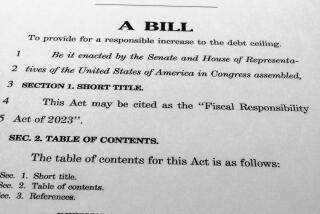Obama’s tax cut victory reflects a change in tactics
- Share via
Reporting from Honolulu — President Obama’s success in getting congressional Republicans to renew a payroll tax cut flowed from a strategy the White House has employed since the summer: Bypass Congress and marshal the political power of middle-class voters fed up with Washington gridlock.
The standoff with House Republican leaders formally ended Friday, when Obama signed a bill that extends for two months a Social Security tax cut for employees and unemployment insurance benefits that had been jeopardized by a weeklong impasse.
The victory is only a partial one for the president. Obama still needs Congress to come back from vacation next month and renew the tax cut through the end of 2012, which remains a major challenge with the two parties far apart on the best ways to pay for the measure.
Speaking to reporters at the White House shortly before flying to Hawaii to join his family for a holiday vacation, Obama said, “When Congress returns, I urge them to keep working, without drama, without delay, to reach an agreement that extends this tax cut as well as unemployment insurance through all of 2012.”
Obama’s tactics in pressuring the Republicans to relent could serve as a template for how the president deals with a hostile House majority in the new year.
The revised approach is rooted in lessons learned from a debacle over the summer. Obama spent weeks holed up in meetings with congressional leaders, trying to resolve a stalemate over raising the debt ceiling.
In the end, Congress complied, but at a severe cost to the nation’s credit rating and Obama’s public standing. Obama could not persuade Republicans to ease deficits through a mix of tax hikes and spending cuts and was perceived as having surrendered to their demands.
In mid-August, Obama’s approval rating dipped below 40% in Gallup’s daily tracking poll for the first time, bottoming out at 38% by month’s end.
Now Obama’s numbers are on the rise. A batch of new polls from the last week shows he is 5 to 10 points above his summer lows — reaching as high as 49% in CNN and ABC News/Washington Post surveys.
As for Congress, its numbers continue to sink. A Gallup poll this week put its approval rating at 11%, the lowest for any Congress since Gallup began asking that question in 1974.
“If the short-term tactical approach was to distance himself from Congress and put him on the side of jobs for the middle class, you’d have to say that that tactical effort has stopped the bleeding and probably shored him up with his base, which was ready to jump ship after the debt ceiling fiasco,” said William Galston, a senior fellow at the Brookings Institution.
Images can shape a presidency, and the public saw very different faces of Obama in the two showdowns with Congress.
Over the summer, Obama was repeatedly photographed sitting glumly in the Cabinet Room of the White House, flanked by dour congressional leaders.
In this latest confrontation, by contrast, Obama surrounded himself with ordinary people. He took his dog to a PetSmart store in northern Virginia earlier in the week and shook hands with shoppers. On Thursday, Obama met with people who had sent letters to the White House telling of the hardships they would face if the payroll tax cut were not renewed. The break gives employees a 2-percentage-point reduction in Social Security taxes, or about $86 per month for the average worker.
Obama seemed more comfortable channeling the outrage of struggling families than he did in the role of a Washington insider trying to browbeat lawmakers behind closed doors.
Hours before the agreement, he said at the Thursday event: “What’s happening right now is exactly why people just get so frustrated with Washington.... This isn’t a typical Democratic-versus-Republican issue. This is an issue where an overwhelming number of people in both parties agree. How can we not get that done?”
The message fits within a recalibration that has played out through the fall. Obama stopped playing the part of “legislator in chief,” in the words of one senior White House aide, who spoke on the condition of anonymity to discuss strategy. He began running against a gridlocked Congress in the style of Harry Truman’s 1948 presidential campaign.
“He’s doing better because what he is doing is seen as separate and apart from what Congress is doing,” said Neera Tanden, president of the Center for American Progress, a center-left think tank. “When he owned Congress” — as was the case during the debt ceiling fight — “Congress was dragging him down.”
Michael Memoli in Oradell, N.J., contributed to this report.
More to Read
Inside the business of entertainment
The Wide Shot brings you news, analysis and insights on everything from streaming wars to production — and what it all means for the future.
You may occasionally receive promotional content from the Los Angeles Times.










